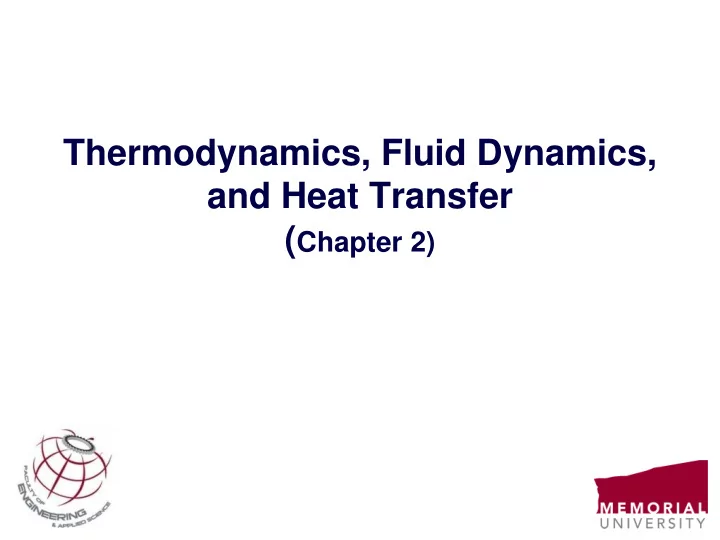

Thermodynamics, Fluid Dynamics, and Heat Transfer ( Chapter 2)
2 Learning Outcomes (Chapter 2) • Review of Thermodynamics – First law, Second law, Exergy • Review of Fluid Dynamics – Conservation of mass, momentum, and Mechanical energy • Review of Heat Transfer – Conduction, Convection, Radiation • Important Dimensionless Groups Faculty of Engineering and Applied Science Memorial University of Newfoundland St. John’s, Newfoundland, Canada
3 Thermal-Fluid Fundamentals • First Law of Thermodynamics – Classic sign convention • (+) for work done by the system, and (-) for work done on the system – Heat Engine convention • (+) for work done on the system, and (-) for work done by the system • This is the “Heat Engine” convention. It is opposite to what you learned. Faculty of Engineering and Applied Science Memorial University of Newfoundland St. John’s, Newfoundland, Canada
4 Thermal-Fluid Fundamentals • First Law of Thermodynamics – The Work Term: • (+) for work done on the system, and (-) for work done by the system • This is the “Heat Engine” convention. It is opposite to what you learned. Faculty of Engineering and Applied Science Memorial University of Newfoundland St. John’s, Newfoundland, Canada
5 Thermal-Fluid Fundamentals • Second Law of Thermodynamics Faculty of Engineering and Applied Science Memorial University of Newfoundland St. John’s, Newfoundland, Canada
6 Thermal-Fluid Fundamentals • Exergy – Reference (dead state) – Increasing exergy – Maximum Faculty of Engineering and Applied Science Memorial University of Newfoundland St. John’s, Newfoundland, Canada
7 Thermal-Fluid Fundamentals • Conservation of Mass and Momentum – Conservation of Mass – Conservation of Momentum – Bernoulli’s Equation Faculty of Engineering and Applied Science Memorial University of Newfoundland St. John’s, Newfoundland, Canada
8 Thermal-Fluid Fundamentals • The Extended Bernoulli Equation: – It is differences in total pressure that drive flow, not static pressure alone . – If flow speed changes, then there may be static pressure recovery. Faculty of Engineering and Applied Science Memorial University of Newfoundland St. John’s, Newfoundland, Canada
9 Thermal-Fluid Fundamentals • Conservation of Mechanical Energy – Convention: • Pumps add energy to fluid. • Turbines extract energy from the fluid. – In words: • Energy at point 1 + Energy added = Energy at point 2 + Energy converted + Losses Faculty of Engineering and Applied Science Memorial University of Newfoundland St. John’s, Newfoundland, Canada
10 Thermal-Fluid Fundamentals • Conservation of Mechanical Energy Faculty of Engineering and Applied Science Memorial University of Newfoundland St. John’s, Newfoundland, Canada
11 Thermal-Fluid Fundamentals • Understanding Mechanical Energy Faculty of Engineering and Applied Science Memorial University of Newfoundland St. John’s, Newfoundland, Canada
12 Thermal-Fluid Fundamentals • How to wisely choose a CV? Faculty of Engineering and Applied Science Memorial University of Newfoundland St. John’s, Newfoundland, Canada
13 Thermal-Fluid Fundamentals • Example 1: Find the force on the T-section, F x and F y . Neglect viscous effects. Assume ρ =1000 (kg/m 3 ). Faculty of Engineering and Applied Science Memorial University of Newfoundland St. John’s, Newfoundland, Canada
14 Thermal-Fluid Fundamentals • Example 2: Analyse flow through the sudden expansion shown in the figure. Faculty of Engineering and Applied Science Memorial University of Newfoundland St. John’s, Newfoundland, Canada
15 Thermal-Fluid Fundamentals • Example 3: If the headloss between points 1 and 2 was calculated of 20 (m), how much power is transferred to the turbine? How much power is ideally derived assuming no losses? Faculty of Engineering and Applied Science Memorial University of Newfoundland St. John’s, Newfoundland, Canada
16 Thermal-Fluid Fundamentals • Example 4: Water flows at a rate of 70 (l/s) Through a flanged faucet with a partially closed gate valve spigot. The inner diameter of the pipe at the location of the flange is 2 (cm), and the pressure at that location is measured to be 90 (kPa). The total weight of the faucet assembly plus the water within it is 60 (N). Calculate the net force on the flange. Faculty of Engineering and Applied Science Memorial University of Newfoundland St. John’s, Newfoundland, Canada
17 Thermal-Fluid Fundamentals • Important Dimensionless Groups Faculty of Engineering and Applied Science Memorial University of Newfoundland St. John’s, Newfoundland, Canada
18 Thermal-Fluid Fundamentals • Conduction Heat Transfer – General heat conduction equation (Cartesian) – Fourier’s Law • k: Conductivity • ρ : Density • c: Heat capacity Faculty of Engineering and Applied Science Memorial University of Newfoundland St. John’s, Newfoundland, Canada
19 Thermal-Fluid Fundamentals • Convection Heat Transfer – Newton’s cooling law – Nusselt number • h: Convection coefficient • L: Characteristic length • k f : Fluid’s conductivity Faculty of Engineering and Applied Science Memorial University of Newfoundland St. John’s, Newfoundland, Canada
20 Thermal-Fluid Fundamentals • Radiation Heat Transfer – Stefan-Boltzmann Law: • ε : Surface emmisivity • F1-2: View factor • σ : Stefan-Boltzmann constant Faculty of Engineering and Applied Science Memorial University of Newfoundland St. John’s, Newfoundland, Canada
Recommend
More recommend